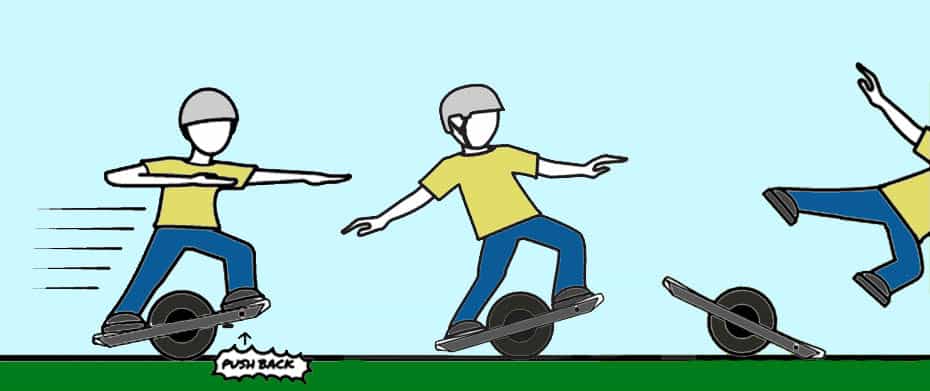
Probably the biggest deterrent for many new riders and potential riders is the concerns of nosediving on a Onewheel. Nosedives are the leading cause of injury on a Onewheel. The injury that can incur from a nosedive typically can range from a bruised ego, bruised arm or shoulder, fractured clavicle or arm, injury to the head or even death. Some riders may have experienced a nosedive while many never have. The nosedive scenario is entirely avoidable and to give the Onewheel a fair shake, we need to understand the physics to nosedives and how riders can prevent them or at the very least mitigate the risk of injury.
A nosedive is when the motor of the Onewheel can no longer maintain the ability to level the rider. This is due to excessive power requested by the rider. The result is the front end drops (‘dive’) thereby abruptly stopping the Onewheel and ejecting the rider.
Why Do Nosedives Occur The Physics Behind the Onewheel
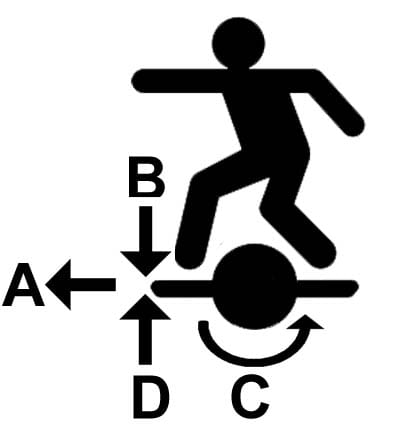
To first understand nosedives, we need to understand how the Onewheel operates. The self-balancing board is balanced by utilizing a combination of sensors and software algorithms. The board has accelerometers and gyroscopes that continuously monitor the rider’s movements and the orientation of the board. This information is processed by the Onewheel’s controller, which then adjusts the spin of the wheel to maintain balance.
The Onewheel has what’s called “Dynamic Stabilization” technology, which uses the motor to actively control the wheel’s rotation. If the rider leans forward, the motor will adjust the wheel’s position to keep the board level. The combination of sensors, algorithms, and motor control allows the Onewheel to balance the rider however the motor has power limits. Exceeding those limits is what causes the dreaded nosedive.
Momentum and Balance of the Onewheel
Here’s a diagram of what’s happening when riding a Onewheel. This diagram can be reversed when the rider reverses:
- A – Speed
- B – Rider’s downward force (requesting power from the motor)
- C – Wheel spin
- D – Upward force (created by the wheel spin)
Staying Level and Balanced
Looking at this diagram we can attempt to better understand how the controller is handling the balancing act. First, to be level (balanced), the B must be equal to D. If B=D then both footpads are at the same height and A = 0. The C variable is created by the controller that constantly is reading (up to 10,000 times per second) the B value and employing a spin in either direction to maintain a level and balance rider. The Onewheel is programmed to level the rider.
Speed on a Onewheel
The key thing to remember is that the Onewheel is programmed so that it always attempts to balance the rider. As explained above, to be balanced B must equal D. As a rider applies downward force to the footpad, to stay level, the D has to apply equal upward force. This is only created by the spin of the wheel. Essentially the wheel is constantly chasing a balanced board when the rider applies force on the nose of the board.
When there is even slight downward force (B), the controller of the Onewheel is programmed to spin the wheel enough to level the rider. In this interim, the spin results in a distance travelled. That distance over time equates to speed.
Why Nosedives Happen?
Imagine the rider applied all of their weight to the nose of the board. Remember, that the Onewheel is programmed to level the rider. In this scenario, with all the weight of the rider on B, the Onewheel will utilize all of its power to spin the wheel (C) to provide ample upward force (D) to level the board. Because there is so much weight on the nose, there becomes a certain point in which the Onewheel cannot attempt to be level (maintain the rider). In this scenario, the B force is greater than D which results in B hitting the ground.
In the time it takes for B to overpower D, Speed (A) has been created which gives the rider momentum. As the nose of the board hits the ground, the momentum of the rider continues on resulting in being “ejected” from the Onewheel.
Pushback on a Onewheel
There are three exceptions to the Onewheel leveling the rider. First is the elevated digital shaping. Second is a near dead battery (tail drag) and lastly pushback. In all scenarios, the controller is reconfigured so that level is redefined at another value where the nose is elevated. In a near dead battery and elevated mode, the controller is constantly riding this setting whereas pushback happens when the rider approaches the limits to the motor.
As the motor reaches its limitations, it will reconfigure level and elevate the nose which is supposed to notify the rider that “Hey rider! I’m pushing back (lifting up the nose) because you are pushing too hard!”
This begs the question, instead of nosediving, why doesn’t the Onewheel just reconfigure level so that it tail drags which would halt the rider? In this scenario, the board has no way to slow you down. With the tail all the way down, there is no way to lessen the force B on the nose. If even some weight is continually applied, eventually you would still overpower the motor. If the wheel slowed down, the result would still end in a nosedive as downward force (B) would be too great for level.
Pushback slightly alters level so that the rider can still unload some of the downward force applied to the nose by shifting some weight to the tail. This helps the controller as the rider is assisting in leveling the board. Doing this keeps the rider within a safe (nosedive-free) zone.
How to Avoid Nosedives on a Onewheel
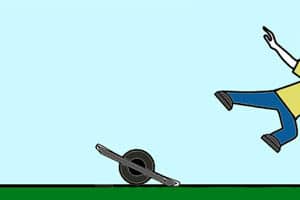
Yes, nosedives are entirely avoidable. While there are recommended speeds and conditions to be more cautious to a potential nosedive, its important to know that these recommendations change with the terrain you are on and need to be modified as you ride. This is the art of being a good and experienced Onewheel rider. Here are the 6 best tips to avoiding nosediving on a one wheel:
Tip #1 – Understand Your Digital Shaping Mode
It doesn’t matter if you are riding a Pint, XR or GT. All Onewheels have digital shaping profiles. These profiles drastically change how the board behaves. It is crucial to understand that the lower digital shaping settings (Sequoia, Cruz, Bay, Roam & Redwood) have a lower max speed which means you will hit pushback much sooner than you may anticipate. Always be aware of the digital shaping mode. If you are riding a friends board, ask what its set to.
Tip #2 – Do Not Start a Downhill Ride at 100%
Onewheels have regenerative braking which can give the battery a slight charge on downhill rides or heavy braking. As a way to protect the lithium-ion battery however, the Onewheel will shut off if the power being sent to the battery from regenerative braking exceeds 100%. Even going slow downhill gives the Onewheel some regen power so if you are aware of the trail and know that it starts with a downward slope in the beginning, start with 90%.
Downhill nosedives are more dangerous because riders do not experience pushback. A downhill nosedive is also harder to outrun when you fall off the board. Play it safe and always make sure your battery is not 100% when heading downhill.
Tip #3 – Do Not Ride with Intensity With Battery Levels Below 33%
You may not be aware however the powerband on the Onewheel is not consistent over the life of the battery. As the battery dies, the board has less torque because it is producing less power. Tricks, bonks, or certain portions of trails may react differently with a low battery.
It is very important to know that not all batteries ride to 0%. An unbalance battery has potential for cutting out at 5%, 10% or even 25%. If you are below 35%, you should be on your way back to your car or home to recharge. You don’t want to nosedive AND be stuck with a dead battery in the middle of a ride.
Tip #4 – Heed Pushback. Always Respect Pushback
The Onewheel does have the ability to ride beyond pushback. Many riders attempt to achieve higher top speeds by riding through pushback. You may have a 160lb friend that can reach a top speed of 25-30mph however the same board may only get a 200lb rider to 20mph before a nosedive.
Experience with testing pushback at certain battery levels is a veteran skill that many experienced riders learn. They have ability to ride at the brink of nosediving however to be safe riders should be riding slower than when pushback kicks in. The speed will vary depending on terrain. While 15 mph (24 kph) is typically safe, be mindful that pushback can kick in sooner on rougher or uphill terrain.
Tip #5 – Avoid Hard Acceleration Uphill and Rough Terrain
Riding uphill and rougher terrain (such as a thick field of grass or soft soil) is more tolling on the motor. If you keep a moderate constant speed, the motor doesn’t have to work as hard as when you are going less than 5mph. When trail riding, you should always try to keep your speeds between 7-15mph. Anything slower, will put more stress on the motor if there is an obstacle such as a root, loose dirt, rocks etc. Being able to keep your momentum going over rough spots helps. It is not advisable to push the motor harder in these areas. Our goal is to keep good speed to ride over it instead.
Wind will even have an impact on the motor as it can cause drag which will result on more stress to the motor. Again, always try to keep a nice constant speed (assuming this is possible if not, do not attempt to accelerate hard in tough spots).
Tip #6 – Always Keep Your Weight Directly Over the Wheel – Never Lean Forward
The last tip is really the most common mistake riders make when nose diving. When riding a Onewheel, you want to make sure that your center of gravity is above the wheel. Think of your weight being in your hips. To go faster on a Onewheel, its simple. We just need to push down on the nose for more acceleration. The problem is that pushing the nose down somehow gets morphed into leaning forward.
When you lean forward, more of your body weight is over the center of the tire. To straighten you out, the motor has to try harder to keep the board balanced. With so much weight over the tire, if there is any roughness in the terrain (root, rock, stump, rough grass), you may over power the motor and experience a nosedive.
Best practice for riding a onewheel is to keep knees bent to lower your center of gravity. Instead of leaning forward to go faster, we shift some weight to the lead foot but do not lean into it. It is actually feasible to push down on the lead foot while leaning back. You just need a slight difference in weight to push down on the nose – slightly greater than 50%. Leaning forward puts far more weight on that nose and over stresses that motor.
Anti-Nosedive Products to the Rescue
Fangs and Sonny wheels are probably the most notable anti-nosedive products on the market. The main difference between the two is that Fangs are a direct bumper replacement and have a more subdued / OEM look to them.
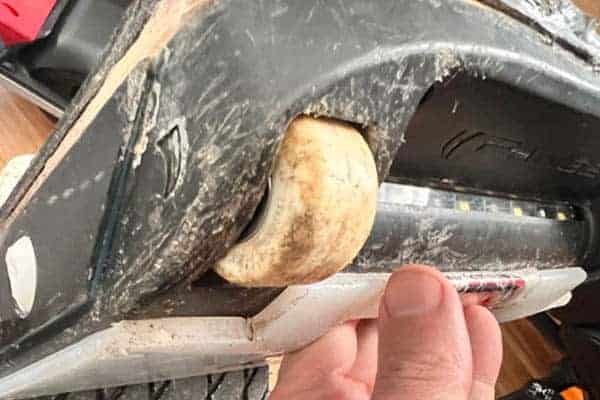
Fangs 2.0+ have the ability to modify the wheels. You can customize your board with a variety of different colored wheels. The wheels are 20mm wide and are just enough to possibly save you from falling.
The intent with fangs is that if you do overpower the board, when that nose hits the ground, ideally you ride it out quick enough on the fangs to recover the nosedive and avoid falling and injury.
As you can see from my Fangs that I get them dirty on trails. I do a great deal of trail riding and they are not a perfect solution. Riding out a nosedive on concrete or cement is possible but on a wooded trail, its more challenging. It is possible if the terrain is hard pack but if its loose, the fangs may only provide nominal help.

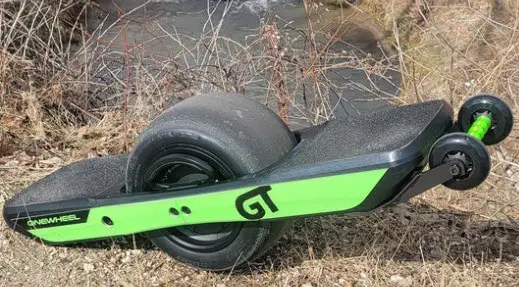
Sonny Wheels are attached to the nose with a slider kit that they provide. These wheels are far larger (size of inline skate tires) and are not built into the bumper like Fangs. Instead these are attached to the front.
Sonny Wheels likely have more ability in saving you from a nosedive (even on trails) however you may be adding on a little more weight and the look of your board. If neither bother you than this is a great solution to keep you floating on.
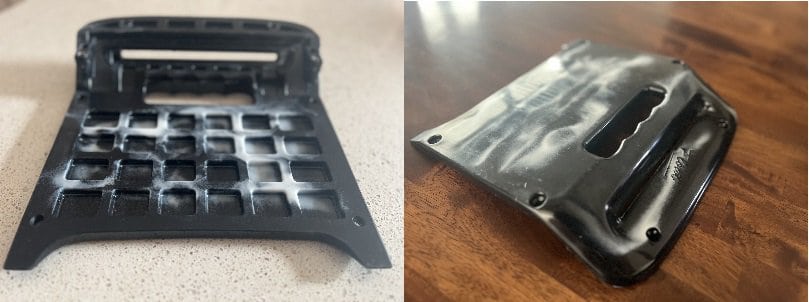
Believe it or not but the B.A.N.G. bumpers also provide some nosedive protection. Granted, they are really intended for that however these bumpers are super thick and incredibly slippery. When the nose hits smooth pavement, less friction happens enabling you to ride out the nosedive.
The Art of Falling on a Onewheel
In board sports, sports in general and the stunt community know how to fall. When riding a one wheel there is no difference. How you fall matters. In the movies when you see a stunt man fall out of a car, you don’t generally see the stunt man just faceplant the asphalt and kiss the pavement. What you typically witness is a professional reduce their momentum slowly instead of abruptly. This is key in falling. We don’t want to immediately halt all of our collected inertia into a griding halt. Instead, we need to use our body to slowly come to a stop.
We always want to avoid the fall however sometimes we fall. So falling properly is what we need to achieve and may take practice. If you are sent over your Onewheel and there is no way to land on the board then the top two ways to mitigate injury is to “run it out” or “roll it out”.
If you’re riding and you are on your feet when you go over the nose, instinctively your body will alert you that you have lost balance. Your reaction time is crucial. In between you leaving your Onewheel and hitting the ground, you need to be prepared to match your speed with running. This is called running it out. You are ‘running out’ the fall. As long as you can match the speed on your feet and slow yourself down, you can usually save yourself from injury.
If you are riding and you are in the air when you go over the board, sometimes your feet are not positioned to outrun a fall. Instead, you need to roll it out. I’ve witnessed some good riders pull 3 or four somersaults after a fall and have no injury. They looked like ninjas! If you cannot land on your feet then you have to literally roll with it. Roll with the fall until you have come to a halt. This is why helmets are great!
Conclusion
Most riders will likely agree that most nosedives are really from overpowering the board by going to fast or overpowering the board with a low battery. Once you ride a few hundred miles, you start to feel the pushback and understand how to ride safely within the limitations of the Onewheel. Staying below pushback will drastically reduce the chance of a nosedive. If you want to play it safe, pick up some Fangs or Sonnywheels for some added protection.
Even a pair of BANG or Bash bumpers slightly help. These are super slippery bumpers that can help slide the nose in the event of a nosedive. This isn’t the intent of their product however I do have a pair of B.A.N.G.s and on asphalt, they slide similar to Fangs. Their true intent is for a rugged bumper to help with tricks (nose slides, grinds, etc.) but they work well even for a nosedive recovery. Any way you go in building your board is up to you. This is a great aspect of Onewheeling. Personalize your board to what makes you feel good and safe and float on!
F.A.Q.’s
There’s a lot of talk about them because they can cause injury however if you follow the guidelines of the board, nosediving is unlikely. For example, a 10 mile street ride within the speed limits of the board would not likely incur a nosedive whereas pushing through pushback on rougher terrain would. How you ride will determine how much potential there is for injury.
Electric stateboards (e-skateboards) typically cannot go over the same types of terrain that a onewheel can. Onewheels have large go-kart tires that overcome most obstacles. On a skateboard, even small rocks on the street can cause you to fall over your board. Its not necessarily called a nosedive with a traditional board however because of the smaller tires, there’s potential to getting caught up on some object which can send you off the board. Get a Onewheel and enjoy the added terrain possibility along with the incredible float like feeling you get from riding.
Fangs work in nosedive recovery. Will they work in every scenario, no. They are not a sure thing however it is just one more added layer of insurance. They are not the best on loose terrain however you can always try Sonnywheels for that.
The “Alarm Footpad Sensor” warning will state “you have been off one foot pad for more than 10 seconds while riding X mph”. The footpad sensor in the front has two zones. It takes weight on both zones to activate the motor. While riding over 1 mph however, only one zone needs to be engaged. This is a safety feature added into the Onewheel. The alert is telling you however that if it doesn’t sense weight on that one side, the motor will disengage. While this alert is typically not a concern, you should look into shoes with better sensor contact.
If you feel that the board did nosedive randomly and it was not related to motor engagement, a dead battery or overpowering the Onewheel, contact Future Motion and provide them with details on the instance.
Because many footpad companies do not want the added risk of injury, they typically recommend going over the original grip tape rather than attempting to peel it off and possibly damaging your sensor. The sensor is what engages the motor so anything added or modifying this may affect the performance of the Onewheel. That being said however, custom footpads are relatively safe. There are complete swaps you can do like a platysense pad. If you do go over your grip tape, it needs to have good clean contact between the added pad and the original tape. If any debris can fit in between, it can cause the board to ghost. Any gaps can cause the sensor to not properly engage.
No, due to the nature of the ‘one’ wheel, the Onewheel is the only board that nosedives. That being said, traditional e-skateboards typically have smaller wheels that can snag something on the road which can eject the rider in a similar fashion. Check out our post on what to look for in an all-terrain electric skateboard.

3 thoughts on “What is a Nosedive on a Onewheel?”